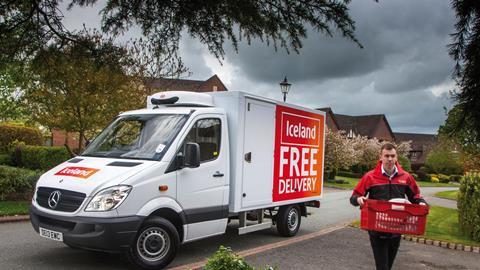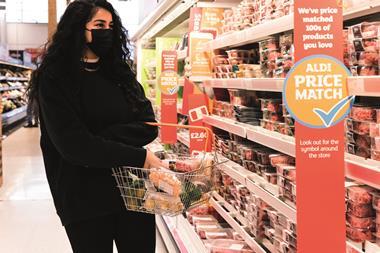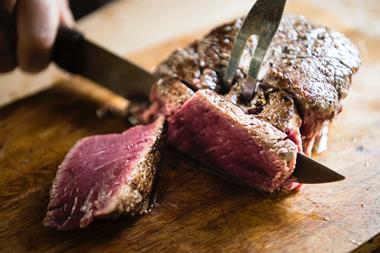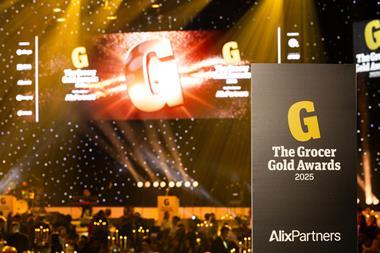With Tesco the latest supermarket to announce Christmas results last week, the dust is now settling following a festive grocery battle in unique times.
So how does each player’s performance stack up against expectations and rivals’?
Kantar figures in this article refer to grocery sales growth in the four weeks to 27 December 2020.
Aldi
Aldi’s trading update put its year-on-year sales growth at 10.6% in the four weeks to Christmas, but Kantar has it trailing rivals, with grocery sales up 6.4%.
Analysts question whether rolling out click & collect and Deliveroo services could have been disruptive, but Aldi rejects this, saying extra staff were taken on to store pick.
However, Aldi stores are on average about 10,000 sq ft, compared with Lidl’s 12,000 sq ft. Under social distancing, that’s a greater physical limit on Aldi’s customer numbers.
Aldi also missed its annual target of 50 new stores in 2020, opening only 37 thanks to construction delays in lockdown, though the long-term target of 1,200 by 2025 is still on course.
Then add Tesco’s Aldi Price Match campaign, launched last March. “You can’t walk into a Tesco without seeing it everywhere,” notes GlobalData retail analyst Thomas Brereton.
Asda
Asda’s own trading update will come from parent Walmart’s Q4 next month. In the meantime, the Kantar figures will have made sobering reading for Asda boss Roger Burnley – Asda scored the slowest growth of the big four, at 9.8% (and was the only one of them to lose market share over the period).
However, the retailer has reasons to be cheerful. Like other supermarkets, it has massively expanded its online offering, with grocery home shopping capacity up by 90% since the first lockdown in March to 850,000 slots.
In the autumn, Asda announced it was throwing £100m at price cuts and reviving its famous Pocket Tap ads. However, its prices will need more of a shake-up to match the likes of Tesco and Aldi.
In the run-up to Christmas, Asda cut prices to 20p a bag for five festive favourites and still found itself outgunned.
“I think Asda will have had a good Christmas, but I’d be surprised if they had the same growth surge as Morrisons, Sainsbury’s and Tesco,” says Shore Capital’s Clive Black.
“We are forecasting a like-for-like sales increase of around 5%.”
The supermarket argues its performance in Kantar’s data will have been affected by stores closing on Boxing Day for the first time.
Iceland
Iceland – which typically doesn’t releases a Christmas trading update – was the fastest-growing bricks & mortar supermarket, according to Kantar, with grocery sales up 19.3%.
The obvious change has been a massive online scale-up, with deliveries up 300% in the 12 months to September, according to the business. But there’s more behind the sales surge than that.
Iceland has opened stores at rate approaching Lidl and Aldi, adding more than 60 since March 2019, while reaching new customers through The Food Warehouse and opening more outlets inside branches of The Range.
Behind it all, “the idea you can get quality food frozen has come to the fore” in the pandemic, adds Brereton.
Lidl
Among bricks & mortar supermarkets, Lidl was behind only Iceland, with sales up 18.8%, according to Kantar. And unlike its frozen specialist rival, it did it without online expansion.
In fact, it did it without online full stop. In September, Lidl GB CEO Christian Härtnagel told The Times: “I haven’t seen a model that could take us online.”
Black argues Lidl is instead becoming a more effective bricks & mortar retailer: “Lidl is proving to be a much more formidable competitor [to Aldi] and I think it has adapted well to the shopping tastes of the British.”
Critics argue Lidl bought some of its sales, with a voucher promotion offering £10 off a £40 basket in December, not to mention deals in the Lidl Plus loyalty scheme, launched in September.
Morrisons
Morrisons’ own trading update put its sales surge at 9.3% in the three weeks to 3 January, while Kantar credited it with 14.1% growth, behind only Tesco among the big four.
Strong performance from its Morrisons.com and ‘Morrisons on Amazon’ service were boosted by a growing food box business, which offered a Christmas dinner in a box for under £20 for families unable to make it to the supermarket.
The retailer now offers click & collect at almost 500 stores across the UK, compared with just 14 in March, helping to increase its online profitability.
“Morrisons has stepped up to the pandemic challenge, along with the rest of the British retail food system it should be said, very well in our view,” says Black.
“It moved quickly to build its online capabilities from a dependency upon Ocado to a rapid expansion of its tie-up with Amazon plus Deliveroo, extensive store pick and click & collect plus the creation of a totally new activity in food boxes and doorstep delivery.”
M&S
M&S’s sales were up 9.5%, according to Kantar, with growth held back by a high number of stores in towns and city centres, which suffered declining footfall under Covid restrictions.
Black says M&S’s store operations nevertheless performed “a little ahead of expectations,” but lagged behind competitors owing to its high number of stores in travel hubs and lack of custom in cafés.
M&S’s own trading update recorded 2.2% growth in food and a 2.6% like-for-like food sales increase in the 13 weeks to 26 December, boosted by Ocado Retail’s 35% revenue growth.
Ocado
With 46.8% growth, Ocado leads the way by a country mile in Kantar data, but for a pureplay e-commerce grocer it’s “little surprise after many months of people transitioning to online”, says Carl Uminski, COO at digital agency Somo.
It would also have been helped at Christmas by M&S’s ranges proving a new ‘wow factor’, says Uminski.
The elephant in the room is capacity constraints inherent in Ocado’s automated warehouse operating model, which contained its growth last year. As an FAQ answer on Ocado’s website explains, “To increase even more capacity we need to build a new warehouse and unfortunately, it’s not possible to build one in a short space of time.”
Black worries it may have impacted shopper loyalty while “new customers could not be squeezed in, including many M&S loyalists”.
Uminski argues: “Its communication remained really good; customers tend to make allowances for companies that are transparent and noticeably trying to fix any problems.”
Sainsbury’s
Sainsbury’s trading update indicated it had outperformed expectations across the board. The supermarket released the results early due to hiking its profit guidance, revealing sales growth of 9.3% in the nine weeks to 2 January.
Kantar puts Sainsbury’s grocery growth at 13.8%.
Sainsbury’s CEO Simon Roberts credits the performance to more shoppers than ever buying food online. The supermarket delivered 1.1 million orders in the 10 days to Christmas Day – double the number of 2019. Online grocery sales rose 128% in the third quarter to account for 18% of total grocery sales, according to the supermarket’s festive update.
In stores, footfall generated by Argos’ click & collect service “might have helped [its] strong performance,” says retail analyst Nick Bubb. Argos sales were up 8.4% in the quarter.
Tesco
As Tesco gave its Christmas trading update last week, new CEO Ken Murphy hailed its 8.1% like-for-like growth in the six weeks to 9 January as “market-leading” – and in any other year it might have been.
But the figures didn’t blow the City away. A 49% plunge in Booker catering sales left the wholesale arm facing an 8.3% like-for-like fall, while Tesco upped its estimate of the cost of Covid by £85m (to £810m), admitting around 30,000 staff were absent because of the pandemic.
Bubb says Tesco’s festive numbers look “only par for the course”, while Black suggests the supermarket has “not shot the lights out”.
Still, in Kantar data, it grew fastest of the big four, up 14.3%.
The 80% increase in online sales Tesco recorded over the 19 weeks to 9 January, worth a whopping £1bn, will have helped. Growing basket value and a 25% increase in customers turning to click & collect will also have boosted online profitability.
Murphy reported positive switching “from all key competitors” following price cuts (though Aldi argues this is only happening online).
Waitrose
While Waitrose isn’t providing a Christmas trading update, Kantar puts the growth at 13.3%.
The supermarket’s premium identity will have been asset, according to analysts, as shoppers looked to treat themselves in a Christmas in lockdown.
Waitrose’s sales “benefited from many fed-up folks deciding to have a good time,” says Black.
This was also its first year going it alone for its e-commerce offer without Ocado, which Black says has had a positive impact on its total sales. It has “pressed on online to very good effect,” he adds.
In August 2020, Waitrose executive director James Bailey told The Grocer the online businesses had reached a £1bn annualised run rate, representing a tripling of turnover since the previous year.




















No comments yet